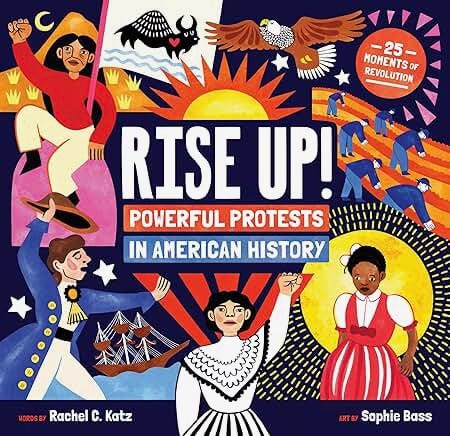Author Rachel C. Katz states, as she opens her book Rise Up! Powerful Protests in American History, that history both enrages and inspires her. She finds it both disappointing and uplifting, and knows it is complicated because people are complicated. How right she is. She also knows that the more we learn about the past, the better we can understand the present. That’s why she became a history teacher. And that is no doubt why she wrote this enlightening picture book.
Protests have marked the history of our country since its beginning. Protests (speaking up and taking action against conditions one feels are wrong) are protected by the 1st Amendment of the United States Constitution. Protests can take many forms: dramatic physical actions such as when colonists dumped valuable British tea into Boston Harbor to demonstrate their opposition to English taxes; the courageous use of one’s voice as when Marian Anderson sang the National Anthem to an interracial audience of 75,000 people at the Lincoln Memorial when she had been barred from performing at Constitution Hall due to her race; the conviction regarding women’s right to equality and to vote that inspired Elizabeth Cady Stanton and others to strategize together drafting the Declaration of Sentiments at the Seneca Falls Convention in 1848…and so many more.
Occupying strategic spaces to resist the installation of a pipeline under Native lands. Bringing landmark cases before the Supreme Court to legalize interracial and gay marriage. Sitting silently at Woolworth’s department store lunch counters which inspired a lengthy boycott until the store changed its policy and served Black customers. Secretly piloting a boat through Confederate waters to freedom, which Robert Small did as an enslaved crew member during the Civil War. Upton Sinclair writing, in his book, The Jungle, a powerful exposé about the deplorably unhealthy conditions in a Chicago meatpacking factory that influenced the Food and Drug Act. The first Pride Parades in 1970 when LBGTQ+ individuals bravely stated who they were and demanded the freedom to express themselves. The incredible stamina people with disabilities showed as they left their mobility devices at the bottom steps of the Capitol in Washington, D. C., in 1990, and crawled to the top step, transforming awareness of the need for comprehensive access to spaces such as public buildings, transportation and schools.
These protests are presented in lyrical stanzas with bold, colorful illustrations capturing the essence of each. Additionally, each is further described in the latter part of the book. Also, there is a map showing where and when these twenty-five protests took place, dotting our country from coast to coast. The combined efforts of author Rachel C. Katz and illustrator Sophie Bass result in a book for young people which describes, clearly and vibrantly, the nature of protests and the importance of using one’s voice and actions to shape a better society.
Our nation has not always exhibited respect and fair play for everyone. Protest is important—by speaking, boycotting, writing, making art, singing songs, and taking action to bring awareness to the values of equality, justice, health and access to the rights described in our founding documents. It can make a lasting difference.
Ages 6-8. Barefoot Books, 2025.
The 1st Amendment: “Congress shall make no law respecting an establishment of religion, or prohibiting the free exercise thereof; or abridging the freedom of speech, or of the press; or the right of the people peaceably to assemble, and to petition the Government for a redress of grievances.”



